DUCATI Panigale V4 25° Anniversario 916 BUILD Thread
- Thread starter BMW Alpina
- Start date
Since I will be replacing the front fork with Ohlins FGR400 and use the 108mm Brembo GP4-RR Caliper, the rotor will need to be spaced out using spacers.
Now, the spacers was aluminum finished and just a simple circle shape... I feel it would look out of place near the BLACK Anodized Brembo T-Drive center carrier, so I decided to Cerakote it in Glacier Black plus lasermarked them with Brembo logo on the area where there are grooves on the Brembo T-Drive rotors.
The Cerakote shop, Sagisi Custom sent me the pictures after he laser marked them... and I think I like it :
:
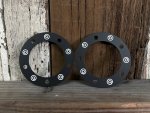
Now, the spacers was aluminum finished and just a simple circle shape... I feel it would look out of place near the BLACK Anodized Brembo T-Drive center carrier, so I decided to Cerakote it in Glacier Black plus lasermarked them with Brembo logo on the area where there are grooves on the Brembo T-Drive rotors.
The Cerakote shop, Sagisi Custom sent me the pictures after he laser marked them... and I think I like it

As you all know, I special ordered my brake line from Goodridge using their 700 Series Aramid Fiber Braided (Kevlar) hose and also special fittings.
The last 3 lines that I ordered, 2 of them arrived with incorrect Metric thread while it supposed to be AN (JIC) thread.
I contacted them and as a result, they ship 2 replacement hose with the fittings in the correct thread
Yes, Goodridge pricing is more expensive than others, but this is why many of the racing teams use them
Here are the incorrect and correct (replacement) lines side by side:
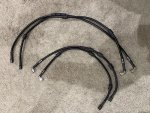
Now, from far away, they look the same, right?
Well here is the close up and you can see that the Metric thread fitting have that "cut" on each corner of the hexagon, while the AN fitting has smoother surface and not "cut" at the corner of their hexagon:
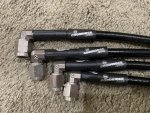
Test fit it with the Staubli AN thread, and it fit much better (not loose anymore):

And here are all the parts I still need to install to complete my front brake modifications for this bike and my 998 :
:
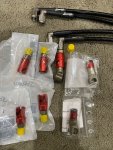
The last 3 lines that I ordered, 2 of them arrived with incorrect Metric thread while it supposed to be AN (JIC) thread.
I contacted them and as a result, they ship 2 replacement hose with the fittings in the correct thread
Yes, Goodridge pricing is more expensive than others, but this is why many of the racing teams use them
Here are the incorrect and correct (replacement) lines side by side:

Now, from far away, they look the same, right?
Well here is the close up and you can see that the Metric thread fitting have that "cut" on each corner of the hexagon, while the AN fitting has smoother surface and not "cut" at the corner of their hexagon:

Test fit it with the Staubli AN thread, and it fit much better (not loose anymore):

And here are all the parts I still need to install to complete my front brake modifications for this bike and my 998

I have a BUNCH of Great Parts arrived for my 998 project today: Ducati 998s FE Final Edition (REPLICA but MODIFIED FAR BEYOND the Original) Build Thread
However, there is one part from Ducati Omaha that was in back order since Black Friday and causing the delay of the delivery of the rest of my order... but it's really worth the wait...
and that is...
Ducati Performance Carbon Add-On for the Gas Tank:
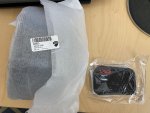
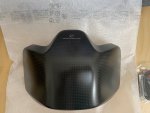
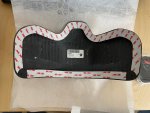
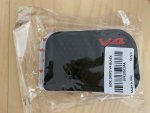
I test fit it and I love it :
:

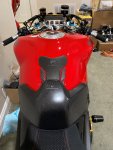
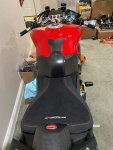
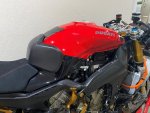

Now, I don't plan to install that Rubber Grip pad though... I like the Carbon Fiber surface more.
I must say, not only it looks good, it also make the ergonomic feel much better when I sit on the bike with it
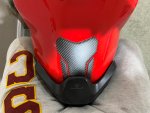
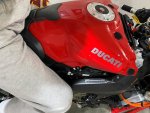
I think I will install it permanently this weekend
However, there is one part from Ducati Omaha that was in back order since Black Friday and causing the delay of the delivery of the rest of my order... but it's really worth the wait...
and that is...
Ducati Performance Carbon Add-On for the Gas Tank:




I test fit it and I love it





Now, I don't plan to install that Rubber Grip pad though... I like the Carbon Fiber surface more.
I must say, not only it looks good, it also make the ergonomic feel much better when I sit on the bike with it


I think I will install it permanently this weekend
Recently, I noticed that one of the hose (the longer one) to the oil cooler touch the SC-Project WSBK exhaust manifold. Right around the area where the pipe is now very BLUE in color, meaning it was heated to at least 500 degree CELSIUS not Fahrenheit but CELSIUS meaning 932 Fahrenheit...
I check the spec Goodridge Stainless Steel Braided hose and even their highest quality model only resist up to 500F or 260 Celsius...
Well, this really made me worry so much that I don't want to turn on my engine again before I found a solution...
Because although from the outside of the hose, I cannot see any burn mark or deterioration, but inside the stainless steel braided... it is possible the PTFE hose (in case Ducati use PTFE hose) is already weaken and could burst oil anytime...
I really don't want to see fire hazard from a burning hot oil onto an even hotter exhaust manifold...
So since last night I was looking for the right solution...
Initially, I am looking for any kind of adapter from Ducati very unique double O-Ring fitting to AN style fitting so I can replace everything easily with Goodridge hoses.
BUT... I could not find any except there are 2 fittings that look close enough in Goodridge latest catalog... which are
Their 960 Plug-In fittings from their HIGHEST and LATEST Ultra series line:

or their 711 Plug-In fitting for their XF line of hoses which until just maybe 2 or 3 years ago was their top of the line hoses.
I actually use the G-Line XF910 Kevlar/Aramid Braided hose for my Setrab Oil Cooler and Fuel Line on my Supercharged Honda Fit project a few years back.
Not only they are the best quality at that time, they also look GORGEOUSLY EXPENSIVE (which they are)

But of course, now Goodridge have the newest ULTRA line, I find this oil cooler hose issue to be the PERFECT excuse to try it..
The difference it the ULTRA line have even higher working and burst pressure to the Stainless Steel inner rings at every valley on the convoluted PTFE hoses.
The ULTRA line also have an even larger inner bore even if the AN value is the same compare to the XF series so they can flow more.
But in order to make sure the hoses and the fitting works, I need to take the current hoses from the bike so here are the steps:
First, I did try to "adjust" the angle by loosening the nut that hold the hose to the oil cooler and I did manage to make the hose have about 5mm to 7mm gap with the exhaust manifold...
So in case I cannot make the Goodridge hose works, I can still use the stock Ducati hose... eventhough I think I might need to replace this hose every few years or so because they are exposed to this kind of crazy heat from the manifold.
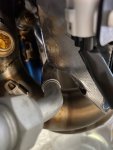
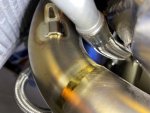
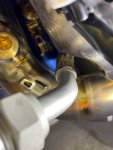
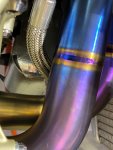
Next step is to drain the oil,... it is a brand new Motul oil that I just filled maybe 1 or 2 months ago... so I am not throwing it away and will reuse it :
:
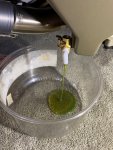
Then loosen the Nut on the oil cooler, but protect it with 3M painters tape so no scratch:
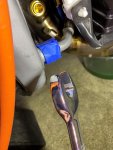
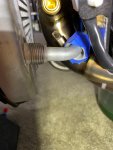
Next, I took off the small nut and fork holder that hold the other end of the hose to the engine block (I did not take pictures) so I am now able to take out the hose:
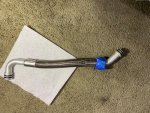
I did check at Ducati Spare Parts Catalog and find that the O-Ring on each end was different... I am curious (that is why I have to take out both end of the hose)...
and turn out the diameter of the fitting going into the oil cooler and the fitting going into the engine block are DIFFERENT :
:

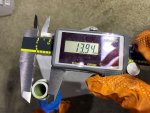
Still this does not provide me with enough information... sooooooooo.... I need to do a "DESTRUCTIVE ANALYSIS" :
:
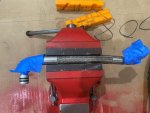
Yeah, time to DREMEL:
So I use cutting grinder to cut both side of the Crimp:
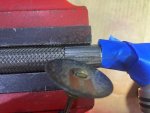
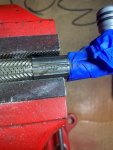
Then pry it apart:
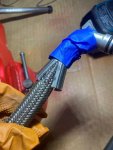
Exposing the PTFE hose inside:

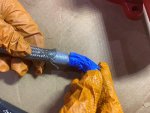
But the fitting was still tightly stuck to the PTFE so I cut the PTFE layer and finally manage to take out the fitting.
What surprise me was that the Stainless Steel use for this braided line was still "magnetic"... a higher quality Stainless Steel is normally NON magnetic:
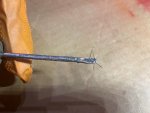
Oh, the first fitting I took off was the 90 degree fitting going into the engine, so I decided to test on whether the current 135 degree fitting (or 45 degree depend on how you look at it), will be good enough to avoid hitting the exhaust manifold:
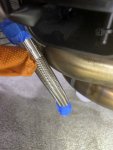

Continue below:
I check the spec Goodridge Stainless Steel Braided hose and even their highest quality model only resist up to 500F or 260 Celsius...
Well, this really made me worry so much that I don't want to turn on my engine again before I found a solution...
Because although from the outside of the hose, I cannot see any burn mark or deterioration, but inside the stainless steel braided... it is possible the PTFE hose (in case Ducati use PTFE hose) is already weaken and could burst oil anytime...
I really don't want to see fire hazard from a burning hot oil onto an even hotter exhaust manifold...
So since last night I was looking for the right solution...
Initially, I am looking for any kind of adapter from Ducati very unique double O-Ring fitting to AN style fitting so I can replace everything easily with Goodridge hoses.
BUT... I could not find any except there are 2 fittings that look close enough in Goodridge latest catalog... which are
Their 960 Plug-In fittings from their HIGHEST and LATEST Ultra series line:

or their 711 Plug-In fitting for their XF line of hoses which until just maybe 2 or 3 years ago was their top of the line hoses.
I actually use the G-Line XF910 Kevlar/Aramid Braided hose for my Setrab Oil Cooler and Fuel Line on my Supercharged Honda Fit project a few years back.
Not only they are the best quality at that time, they also look GORGEOUSLY EXPENSIVE (which they are)

But of course, now Goodridge have the newest ULTRA line, I find this oil cooler hose issue to be the PERFECT excuse to try it..
The difference it the ULTRA line have even higher working and burst pressure to the Stainless Steel inner rings at every valley on the convoluted PTFE hoses.
The ULTRA line also have an even larger inner bore even if the AN value is the same compare to the XF series so they can flow more.
But in order to make sure the hoses and the fitting works, I need to take the current hoses from the bike so here are the steps:
First, I did try to "adjust" the angle by loosening the nut that hold the hose to the oil cooler and I did manage to make the hose have about 5mm to 7mm gap with the exhaust manifold...
So in case I cannot make the Goodridge hose works, I can still use the stock Ducati hose... eventhough I think I might need to replace this hose every few years or so because they are exposed to this kind of crazy heat from the manifold.




Next step is to drain the oil,... it is a brand new Motul oil that I just filled maybe 1 or 2 months ago... so I am not throwing it away and will reuse it

Then loosen the Nut on the oil cooler, but protect it with 3M painters tape so no scratch:


Next, I took off the small nut and fork holder that hold the other end of the hose to the engine block (I did not take pictures) so I am now able to take out the hose:

I did check at Ducati Spare Parts Catalog and find that the O-Ring on each end was different... I am curious (that is why I have to take out both end of the hose)...
and turn out the diameter of the fitting going into the oil cooler and the fitting going into the engine block are DIFFERENT


Still this does not provide me with enough information... sooooooooo.... I need to do a "DESTRUCTIVE ANALYSIS"

Yeah, time to DREMEL:
So I use cutting grinder to cut both side of the Crimp:


Then pry it apart:

Exposing the PTFE hose inside:


But the fitting was still tightly stuck to the PTFE so I cut the PTFE layer and finally manage to take out the fitting.
What surprise me was that the Stainless Steel use for this braided line was still "magnetic"... a higher quality Stainless Steel is normally NON magnetic:

Oh, the first fitting I took off was the 90 degree fitting going into the engine, so I decided to test on whether the current 135 degree fitting (or 45 degree depend on how you look at it), will be good enough to avoid hitting the exhaust manifold:


Continue below:
And turn out you can see that it will still hit the exhaust manifold even when I angle it further below:

Well, this can only means that I will need to find a fitting that is 90 degree going into the oil cooler and I already know where to find it.
So if you see on the right side of the oil cooler, that fitting going into the oil cooler is 90 degree, so even if I fail to find an equivalent Goodridge fitting, I can always just buy another Ducati oil hose for the right side and cut the hose to extract the 90 degree fitting...
But then you guys might be confuse on why I am so worried? well if you look closer not only the diameter of fitting going into oil cooler and going into engine block are different, but the fitting going into oil cooler also tightened by that GIANT Nut and I believe the Goodridge design will not allow a nut to pass through...
By the way, here is the PTFE (TEFLON) Inner hose and Stainless Steel Braided outer hose... So I am glad to see that Ducati is using a PTFE hose and not just some regular AN hose... although I was hoping their stainless steel braided material is a higher quality non magnetic stainless but... this is not that bad in term of quality.
Of course nothing compare to the after market like from Goodridge or Earl or Aeroquip or FrenTubo of course....
Oh, I did go through FrenTubo catalog and they do have some interesting plug-in dual o-ring to 3/4 thread adapter for MV Agusta oil cooler hose... but my feeling is those are just too big...
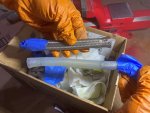
This is a picture from someone selling the Panigale V4 oil cooler hose on eBay, just to show you the different in fitting angle between the left and right hose (and also the length):
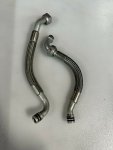
Now, here is the diameter of the fitting going into the hose and they are both the same at 13.19mm
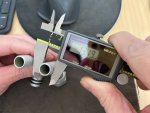
This is the inner diameter of the PTFE (TEFLON) hose:

Based on the 2 dimensions above, I found out that the XF hoses size AN8 is a PERFECT FIT.... too bad the latest ULTRA Series with their larger inner bore is just too big so I cannot use it:

So in the table above the Part# 811-08 have inner diameter of 12.70mm and my measurement above at 12.80mm (after it had been used) is well cannot get more closer than that... so 811-08 XF Series hose will be.
Take a look at the Stainless Steel Braided where it have some "pattern" on it... look much nicer than stock.
Also, I can't use the Aramid Fiber like my previous project because the Aramid Fiber despite lighter but have less temperature resistance than a stainless steel braided, so for this application so close to a glowing blue manifold...
Stainless Steel braided is my choice.
Next, I did some more measurements just to collect all the data:
Outer Diameter of the PTFE hose:
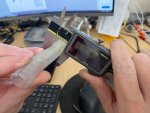
Outer Diameter of the Stainless Steel Braided:
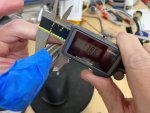
And if you compare to the spec above, the Goodridge XF series has smaller OUTER Stainless Steel Braided diameter compare to stock Ducati.
This show how advanced the Goodridge XF series is that it can have the same inner diameter as the stock Ducati with thinner wall and resistance to a super high temperature but lighter in weight.
Ok... now I need to buy the hose and test the alignment of the 2 ends of the fitting
Finally, I found the way to replace the oil cooler hose for our bike with Goodridge

Well, this can only means that I will need to find a fitting that is 90 degree going into the oil cooler and I already know where to find it.
So if you see on the right side of the oil cooler, that fitting going into the oil cooler is 90 degree, so even if I fail to find an equivalent Goodridge fitting, I can always just buy another Ducati oil hose for the right side and cut the hose to extract the 90 degree fitting...
But then you guys might be confuse on why I am so worried? well if you look closer not only the diameter of fitting going into oil cooler and going into engine block are different, but the fitting going into oil cooler also tightened by that GIANT Nut and I believe the Goodridge design will not allow a nut to pass through...
By the way, here is the PTFE (TEFLON) Inner hose and Stainless Steel Braided outer hose... So I am glad to see that Ducati is using a PTFE hose and not just some regular AN hose... although I was hoping their stainless steel braided material is a higher quality non magnetic stainless but... this is not that bad in term of quality.
Of course nothing compare to the after market like from Goodridge or Earl or Aeroquip or FrenTubo of course....
Oh, I did go through FrenTubo catalog and they do have some interesting plug-in dual o-ring to 3/4 thread adapter for MV Agusta oil cooler hose... but my feeling is those are just too big...

This is a picture from someone selling the Panigale V4 oil cooler hose on eBay, just to show you the different in fitting angle between the left and right hose (and also the length):

Now, here is the diameter of the fitting going into the hose and they are both the same at 13.19mm

This is the inner diameter of the PTFE (TEFLON) hose:

Based on the 2 dimensions above, I found out that the XF hoses size AN8 is a PERFECT FIT.... too bad the latest ULTRA Series with their larger inner bore is just too big so I cannot use it:

So in the table above the Part# 811-08 have inner diameter of 12.70mm and my measurement above at 12.80mm (after it had been used) is well cannot get more closer than that... so 811-08 XF Series hose will be.
Take a look at the Stainless Steel Braided where it have some "pattern" on it... look much nicer than stock.
Also, I can't use the Aramid Fiber like my previous project because the Aramid Fiber despite lighter but have less temperature resistance than a stainless steel braided, so for this application so close to a glowing blue manifold...
Stainless Steel braided is my choice.
Next, I did some more measurements just to collect all the data:
Outer Diameter of the PTFE hose:

Outer Diameter of the Stainless Steel Braided:

And if you compare to the spec above, the Goodridge XF series has smaller OUTER Stainless Steel Braided diameter compare to stock Ducati.
This show how advanced the Goodridge XF series is that it can have the same inner diameter as the stock Ducati with thinner wall and resistance to a super high temperature but lighter in weight.
Ok... now I need to buy the hose and test the alignment of the 2 ends of the fitting
Finally, I found the way to replace the oil cooler hose for our bike with Goodridge
MaverickiB
Well-known member
You already did the legwork, so it's probably a bit late, but Superbike Unlimited ran into the same problems on their V4R build and had to get custom length oil cooler hoses. They'd be a good resource to contact if you want to verify specs on what fits.
Thanks so much for the information MaverickiB,You already did the legwork, so it's probably a bit late, but Superbike Unlimited ran into the same problems on their V4R build and had to get custom length oil cooler hoses. They'd be a good resource to contact if you want to verify specs on what fits.
If the Goodridge hose did not fit, I will reach out to Superbike Unlimited and source the hoses from them.
I bought a pair of NANO LED Combo Light (Tail Light and Brake Light) a few years ago... and I just remember about it... so here it is  :
:
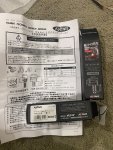
First I test it with a 9Volts battery to check which wire for Tail Light and which wire for Brake Light:
Tail Light:
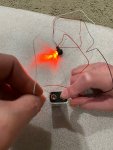
and the much more brighter Brake Light, its almost like it's spitting FIRE there :
:
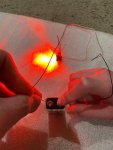
Then I protect this tiny wires with outer braid from Flexo in Uptown Gold color, cut it to length first using special heating cutter:
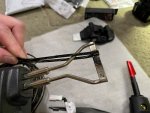
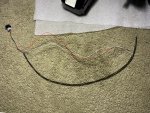
And INSTALLED and PROTECTED:
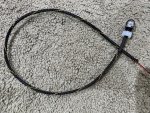
Next, use 3M double tape to temporarily secure it... well not temporarily, the right word is to hmmmm.... reserve the location maybe hahaha.... well you guys will understand later.
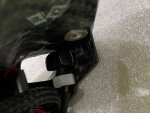

The location is in the opening holes on the Ducati Performance License Plate Holder:
These 4 pictures below are brake light so they are very bright, exactly like it is spitting FIRE :
:

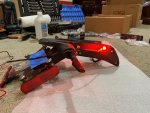
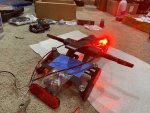
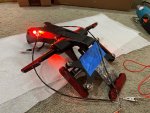
All the above are brake light and the picture below is the more subdue (less bright) tail light which is still quite bright:
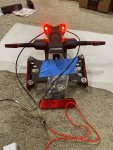
And test fit on the bike... just to see if I really like the looks and yes I LOVE the looks :
:
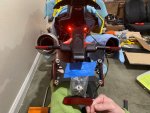
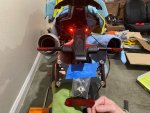
So, now the next step, left picture below is to show the 3M duct tape and on the right picture, I add EPOXY to PERMANENTLY secure them:


And now I am just waiting for the epoxy to dry overnight and I will soon work on the wiring connector
Oh, I also assemble back my resonator box (part# from Superleggera V4) with the Superleggera V4 lower intake channel and the headlight,
But I cannot install the headlight back until I replace the front forks (and maybe the lower triple clamp too)
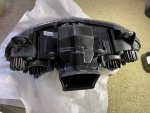
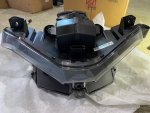
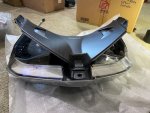

First I test it with a 9Volts battery to check which wire for Tail Light and which wire for Brake Light:
Tail Light:

and the much more brighter Brake Light, its almost like it's spitting FIRE there

Then I protect this tiny wires with outer braid from Flexo in Uptown Gold color, cut it to length first using special heating cutter:


And INSTALLED and PROTECTED:

Next, use 3M double tape to temporarily secure it... well not temporarily, the right word is to hmmmm.... reserve the location maybe hahaha.... well you guys will understand later.


The location is in the opening holes on the Ducati Performance License Plate Holder:
These 4 pictures below are brake light so they are very bright, exactly like it is spitting FIRE




All the above are brake light and the picture below is the more subdue (less bright) tail light which is still quite bright:

And test fit on the bike... just to see if I really like the looks and yes I LOVE the looks


So, now the next step, left picture below is to show the 3M duct tape and on the right picture, I add EPOXY to PERMANENTLY secure them:


And now I am just waiting for the epoxy to dry overnight and I will soon work on the wiring connector
Oh, I also assemble back my resonator box (part# from Superleggera V4) with the Superleggera V4 lower intake channel and the headlight,
But I cannot install the headlight back until I replace the front forks (and maybe the lower triple clamp too)



A UPS package arrived today... containing my GOODRIDGE 811 PTFE Stainless Steel Braided 8AN hose YEEEEAAAAA 
Ok here is how it looks:
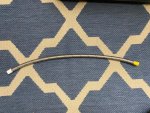
and how about some close up to show those pretty stripes :
:
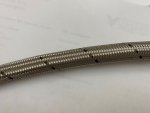
Ok Gorgeous, now see if you are a good "tight" fit... for the stock Ducati Fitting of course . and well well, you are a PERFECT FIT, "JUST THE RIGHT SIZE"
. and well well, you are a PERFECT FIT, "JUST THE RIGHT SIZE"  :
:
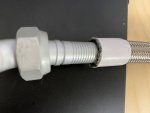
Ok, how about we test both side... still PERFECT, oh by the way, this hose is 2 feet in length because I am planning to replace both inlet and outlet hoses :
:
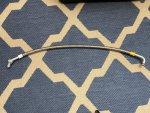
Now, let's see some "flexibility" for "going into certain position" , wow you are quite flexible...
, wow you are quite flexible...
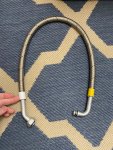
But can we do more bending? Yes Please :
:
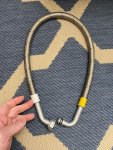
PERFECT, so next, I need to wait for the Goodridge official crimp to arrive and we are ready to go GOODRIDGE for oil cooler hose
Ok here is how it looks:

and how about some close up to show those pretty stripes

Ok Gorgeous, now see if you are a good "tight" fit... for the stock Ducati Fitting of course

Ok, how about we test both side... still PERFECT, oh by the way, this hose is 2 feet in length because I am planning to replace both inlet and outlet hoses

Now, let's see some "flexibility" for "going into certain position"

But can we do more bending? Yes Please

PERFECT, so next, I need to wait for the Goodridge official crimp to arrive and we are ready to go GOODRIDGE for oil cooler hose
It's been a bit more than 2 years since I started buying parts for my build... and somehow there is always a new parts to purchase  like this one:
like this one:
CNC Racing Oil Pan Protector
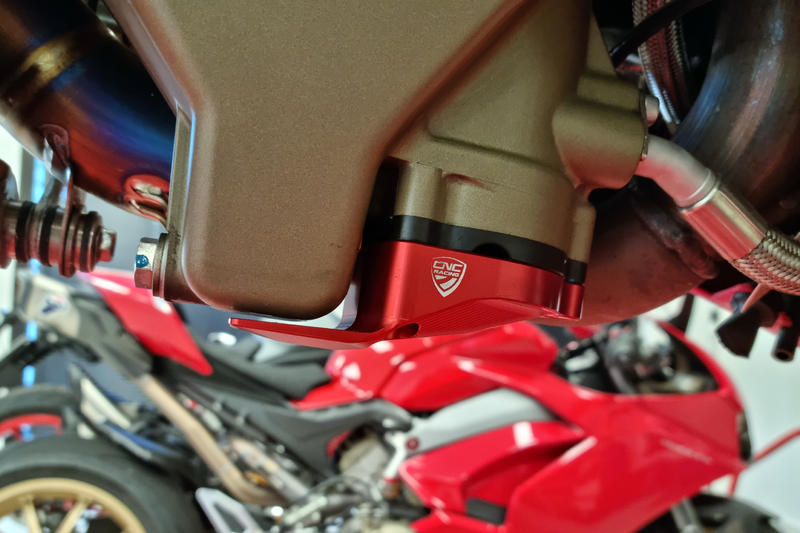
By the way, our official forum vendor,
@CNC_Racing
also offer the rear shock link now, and they offer 2 different length, standard height and 15mm lower. My AELLA lowering link was 20mm lowered, so this CNC Racing 15mm lower would had been perfect,... but I am not going to take out my rear suspension link again... I had enough of doing that .
.
Here are their lowering links:
Standard Height: Tie Rod Rear shock Absorber Ducati Panigale V4 / Streetfighter V4
15mm lower height: Tie Rod Rear shock Absorber Lower seat position Ducati Panigale V4 / Streetfighter V4
Pictures:
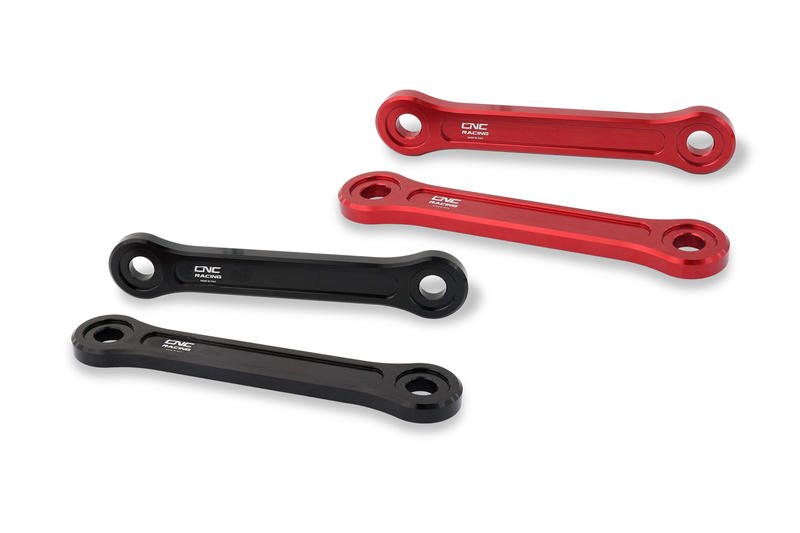
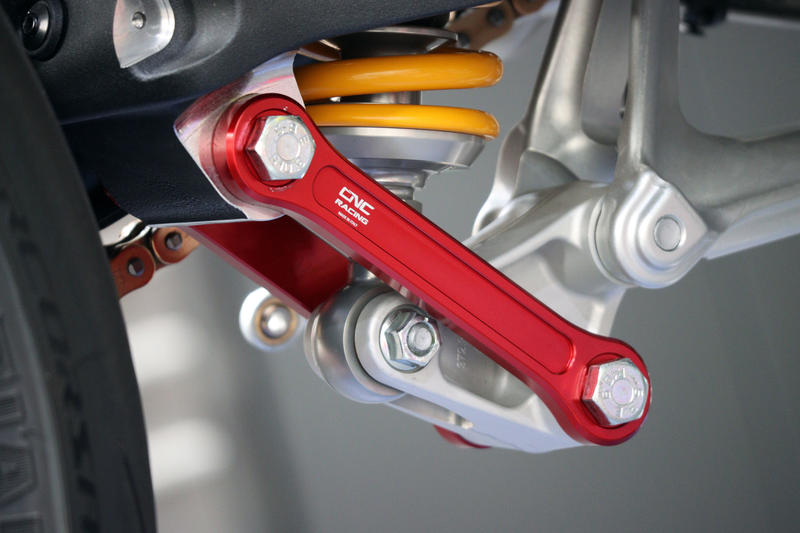
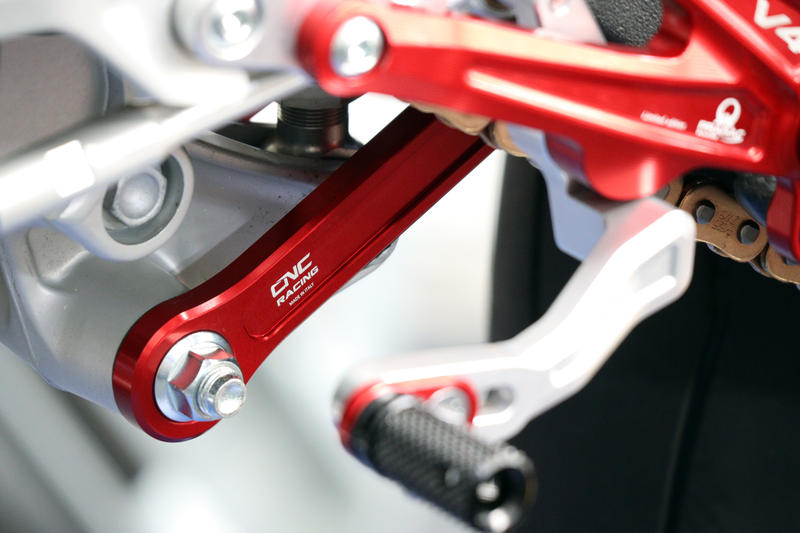
CNC Racing Oil Pan Protector

By the way, our official forum vendor,
@CNC_Racing
also offer the rear shock link now, and they offer 2 different length, standard height and 15mm lower. My AELLA lowering link was 20mm lowered, so this CNC Racing 15mm lower would had been perfect,... but I am not going to take out my rear suspension link again... I had enough of doing that
Here are their lowering links:
Standard Height: Tie Rod Rear shock Absorber Ducati Panigale V4 / Streetfighter V4
15mm lower height: Tie Rod Rear shock Absorber Lower seat position Ducati Panigale V4 / Streetfighter V4
Pictures:



MaverickiB
Well-known member
Is that oil pan protector not for the Streetfighter mostly? Don't see how it would be much use on a Panigale, but have seen Streetfighter ones get beat up by rocks and whatnot and guys have rigged protectors for it.
@Apuca just posted on the CNC Racing section (link here: CNC Racing Oil Pan ProtectorIs that oil pan protector not for the Streetfighter mostly? Don't see how it would be much use on a Panigale, but have seen Streetfighter ones get beat up by rocks and whatnot and guys have rigged protectors for it.
that his Panigale V4 suffer damage from bottoming up on the ramp damaging both his superleggera fairings and oil pan
For me, I just love the looks peeking out from the hole of the lower carbon belly pan from Peter Lieb
Talking about that carbon belly pan, I also have another modification for it soon, just have so much things to do for the 998 now...
MaverickiB
Well-known member
That makes sense. I have definitely scraped the belly pan while loading it up in a trailer. Angle wasn't very steep, so I bet loading it up into a truck could cause a more extreme mishap. Learned why I always see race bikes loaded up with the belly pans removed.
i have that same tank extender and i absolutely love it. i really do not like the grips that came with it as they do not grab and i hate the v4 symbol reminds me of the gsxr bros. a guy on panigale forum told had tech spec make him some but he needs weeks before they will make me any. im considering putting stomp grips and cutting them but it wont look "perfect" what are you considering?I have a BUNCH of Great Parts arrived for my 998 project today: Ducati 998s FE Final Edition (REPLICA but MODIFIED FAR BEYOND the Original) Build Thread
However, there is one part from Ducati Omaha that was in back order since Black Friday and causing the delay of the delivery of the rest of my order... but it's really worth the wait...
and that is...
Ducati Performance Carbon Add-On for the Gas Tank:
View attachment 7439View attachment 7440
View attachment 7441View attachment 7442
I test fit it and I love it:
View attachment 7444 View attachment 7443
View attachment 7445View attachment 7447
View attachment 7446
Now, I don't plan to install that Rubber Grip pad though... I like the Carbon Fiber surface more.
I must say, not only it looks good, it also make the ergonomic feel much better when I sit on the bike with it
View attachment 7448View attachment 7449
I think I will install it permanently this weekend
Hello Max,i have that same tank extender and i absolutely love it. i really do not like the grips that came with it as they do not grab and i hate the v4 symbol reminds me of the gsxr bros. a guy on panigale forum told had tech spec make him some but he needs weeks before they will make me any. im considering putting stomp grips and cutting them but it wont look "perfect" what are you considering?
I did not plan to install the "grip" at all, like you I also hate the V4 symbol, look so cheap compared to the carbon fiber tank extender so I do not plan to install them.
I do find some nicer alternatives though in case you are interested:
Sport Tank Leaf for the DUCATI PANIGALE V2 20-21
OneDesign Ducati Panigale V4 Tank Pad - Billetta Imports
Eazi-Grip PRO Tank Grips for Ducati Panigale V4, clear or black
R&G Racing Tank Traction Grips Ducati Panigale V4 / Streetfighter V4 - RevZilla
Hmmm... If that is the case, I guess the only solutions is to cut them to the right shape or purchase that Luimoto version and take them to a custom leather/upholstery shop, so they can recreate the nice stitching.Hi Howard,
Those are all nice also stomp grips are great but not sure those will work with the tank extender as they extend past the extender itself and the tank extender buldges out
What do you think?
Ya the only issue with cutting them is I think they will look bad and not professional. I don’t think the lui moto are actual good grips but just looks. Ah oh well thank you for your help buddy. I’m happy you like the tank extender I got roasted on fb and by some riders about how “ugly” it is and I’m like you guys have no idea how beautiful this piece is in person.Hmmm... If that is the case, I guess the only solutions is to cut them to the right shape or purchase that Luimoto version and take them to a custom leather/upholstery shop, so they can recreate the nice stitching.
What do you think?
